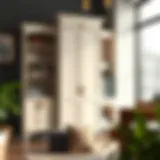E12 LED Bulb Options at Lowe's: A Comprehensive Guide
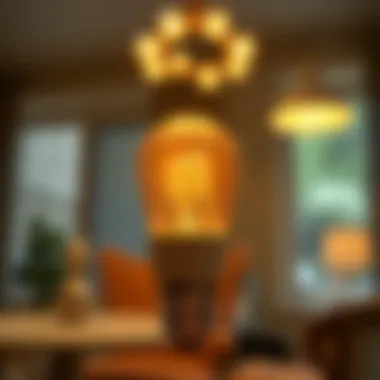
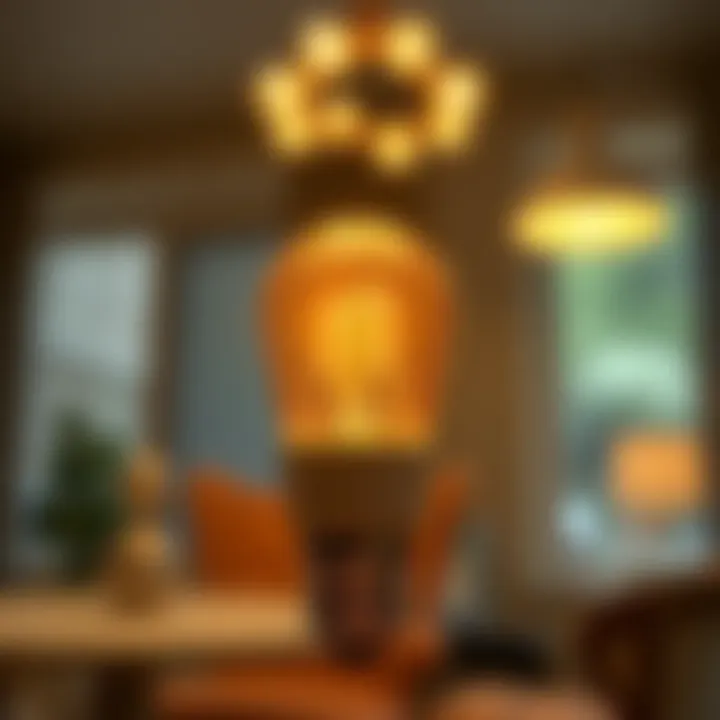
Intro
In today’s energy-conscious world, light bulbs have come a long way, and the E12 LED bulb is no exception. These bulbs, also known as candelabra bulbs, come in a petite size with a multitude of designs and features that make them suitable for various applications around the house. Whether you’re looking to bring a soft glow to a living space or a bright light to your workspace, E12 bulbs offer versatility and efficiency.
Lowe's, a home improvement giant, has an impressive selection of E12 LED options, each with its own unique attributes to cater to the diverse needs of homeowners and design aficionados alike. From decorative lighting needs to practical tasks, these bulbs can be just the right touch. But how do you navigate through this sea of choice? This guide aims to shed light on the features, types, and applications of E12 LED bulbs available at Lowe’s, providing valuable insights that can aid in your decision-making process.
The multitude of benefits LED technology offers—such as exceptional energy efficiency, longevity, and environmental friendliness—merit a thorough review. This article seeks to illuminate the best practices for selecting, installing, and maintaining these bulbs while considering aesthetics and functionality.
In the paragraphs that follow, we will break down several aspects of E12 LED bulbs including their design variations, energy savings, installation tips, and cost factors that play a crucial role in enhancing your lighting experience.
Understanding E12 LED Bulbs
When it comes to lighting, understanding your options is vital. E12 LED bulbs are one such option that has garnered attention for their versatility and efficiency. Knowing the ins and outs of these bulbs can empower homeowners and designers alike to make informed choices, tailored specifically to their outlet needs. Essentially, E12 bulbs are another terminology for a candelabra-style bulb base, and they're commonly utilized in decorative fixtures like chandeliers and sconces. Their compact shape makes them ideal for settings where space is tight but light is necessary.
What is an E12 Bulb?
At its core, the E12 bulb boasts a base thickness of 12 millimeters, which is where the designation comes from. Most folks encounter these bulbs in places like living rooms or dining areas, draping over a dining table or illuminating a cozy nook. Beyond mere decoration, E12 bulbs serve practical purposes by offering effective light output in confined spaces.
One could argue that these bulbs punch above their weight. You might not think much of a small candelabra bulb, yet they can pack a serious brightness punch when equipped with LED technology. With a spectrum of color temperatures to choose from, E12 bulbs allow for creative lighting schemes to match any mood or setting. Newly designed energy-efficient options have the added benefit of reducing electricity usage, making them not just visually appealing but also cost-effective in the long run.
LED Technology Explained
LED stands for Light Emitting Diode, a technology that's revolutionizing how we think about lighting. Unlike traditional incandescent bulbs, which create light by heating a filament until it glows, LEDs utilize a semiconductor to convert electricity directly into light. This process not only reduces energy consumption but also extends the lifespan of the bulb significantly.
For those tied to numbers, consider this: an E12 LED bulb can last upwards of 25,000 hours, compared to a mere 1,000 hours for incandescent counterparts. Not only does this mean fewer light bulb purchases over time, but it also translates to reduced waste in our landfills, addressing environmental concerns that many are becoming increasingly aware of.
Moreover, LED technology allows for a variety of designs. You can find the warm, inviting glow akin to traditional bulbs or opt for cool, crisp lighting suited for tasks requiring concentration. This flexibility in color temperature and design opens up numerous avenues for creativity in interior spaces.
It's crucial to realize why knowing E12 bulbs and their capabilities matters. They offer various lighting solutions tailored to needs, from cozy family settings to professional spaces. The intersection of design, energy efficiency, and innovativeness makes E12 LED bulbs a worthwhile consideration for anyone looking to light up their life in a meaningful way.
The Benefits of E12 LED Bulbs
E12 LED bulbs are becoming increasingly popular, particularly due to their myriad advantages over traditional lighting options. By focusing on energy efficiency, longevity, and environmental impact, homeowners, designers, and DIY enthusiasts alike can make informed decisions about their lighting needs. Understanding these benefits can enhance not just individual spaces, but also contribute to overall well-being and reduced utility costs.
Energy Efficiency
One of the most critical benefits of E12 LED bulbs is their energy efficiency. These bulbs use significantly less energy compared to their incandescent counterparts. For instance, an E12 LED bulb typically consumes about 5 to 10 watts, while an incandescent bulb can consume upwards of 40 watts. This disparity can lead to savings on your electricity bill while still providing the same amount of light, measured in lumens. In fact, it’s not uncommon for households to see reductions in their energy expenses by 50% or more simply by switching to LED lighting.
"Switching to LED not only conserves energy but ultimately allows for a more sustainable lifestyle."
In a world where electricity prices can fluctuate considerably, choosing more efficient lighting options is a savvy financial move. It is worth noting that the Energy Star label can help customers identify high-efficiency products, ensuring they opt for bulbs that meet rigorous energy-saving criteria.
Longevity Compared to Traditional Bulbs
Another striking benefit of E12 LED bulbs lies in their longevity. Unlike incandescent bulbs, which generally have a lifespan of around 1,000 hours, E12 LEDs can last anywhere from 15,000 to 25,000 hours. This translates to less frequent replacements, which is not only convenient but also cost-effective. Imagine only changing your bulbs once every few years instead of several times a year – it really adds up in terms of time and money saved.
The durability of these bulbs is also noteworthy. E12 LEDs are built to resist heat and have a robust design that is less likely to break compared to traditional glass bulbs. This makes them suitable for a variety of applications, from delicate chandeliers to outdoor fixtures.
Environmental Impact
The environmental impact of choosing E12 LED bulbs cannot be underestimated. These bulbs contain no hazardous materials such as mercury, which is often found in compact fluorescent lamps (CFLs). When it comes to waste reduction, the longer lifespan of LED bulbs means fewer replacements and less waste in landfills. Also, the energy they consume is lower, resulting in a decreased demand for electricity. This can ultimately lead to fewer carbon emissions, contributing to a healthier planet.
Furthermore, as more households adopt E12 LED bulbs, the cumulative effect can lead to a significant decrease in overall energy consumption. In light of climate concerns, moving towards sustainable lighting options becomes increasingly relevant, not just for individual households, but for society at large.
Exploring Lowe's E12 LED Bulb Range
When it comes to lighting solutions, E12 LED bulbs stand out for their versatility and efficiency. At Lowe's, customers can find a wide variety that serves different purposes. The importance of exploring these options can't be overstated, especially for homeowners and designers keen on enhancing their living or workspace. With numerous styles available, understanding the E12 LED bulb range aids in making informed decisions about their specific applications and advantages.
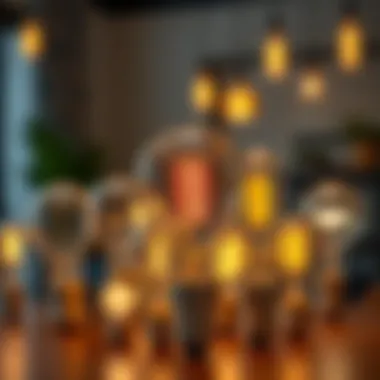

Standard E12 LED Bulbs
Standard E12 LED bulbs are typically direct replacements for traditional incandescent bulbs. They usually fit in chandeliers, sconces, and other decorative lighting fixtures that use the smaller base size. The most significant benefit lies in their energy-saving capabilities, using a fraction of the energy consumed by incandescent bulbs. For instance, a standard 6-watt E12 LED bulb can provide the same light output as a 40-watt incandescent.
Moreover, Lowe's standard options often showcase a variety of wattages, lumens, and finishes that can cater to diverse aesthetic and functional needs. Whether you prefer a soft white warmth or a bright daylight effect, the selection is ample. The end result is lighting that doesn't merely illuminate spaces but enhances the overall look of any room. Investing in quality standard E12 LED bulbs benefits both the environment and the electricity bill, making them a smart choice for budget-conscious shoppers.
Decorative E12 LED Bulbs
On the more stylish end of the spectrum are decorative E12 LED bulbs. These are not just about illuminating but also about making a statement. Think vintage-style Edison bulbs that lend an antique vibe to a space. Decorative varieties, often seen in pendant lights or exposed fixtures, can transform an ordinary room into something extraordinary. At Lowe's, you'll find options that come with various filament styles and finishes, providing ample choice for personal flair.
It's important to mention the aesthetic flexibility these decorative LEDs offer. They can be used in settings ranging from cozy home interiors to more formal contexts like restaurants or boutiques. Their ability to blend form and function is a major draw for many buyers. Investing in decorative E12 LED bulbs means you're not just adding light; you're elevating your decor to a whole new level.
Dimmer-Compatible Options
Dimmer-compatible E12 LED bulbs are what savvy homeowners and designers should definitely consider. These bulbs allow for customizable lighting, letting you set the right ambiance whether for a quiet dinner or an energetic gathering. Choosing dimmable varieties means you’re tapping into a flexible lighting solution that caters to varying needs at different times.
Lowe's offers a range of these compatible options, ensuring that there's something for every dimmer switch on the market. It's vital to check compatibility because not all LED bulbs play nicely with dimmer systems. However, using quality dimmable bulbs can lead to enhanced lifespan and performance. Users often rave about the smooth transition from bright to soft light without flickering, a common issue with lesser quality products.
"Opting for dimmable E12 LED bulbs not only saves energy but also enriches your environment, turning lighting into a dynamic aspect of home design."
In summary, exploring Lowe's E12 LED bulb range ensures you understand not just the physical products available but also their applications and benefits. By grasping the distinctions between standard, decorative, and dimmer-compatible options, you position yourself to make smarter lighting choices that reflect both practicality and style.
How to Choose the Right E12 LED Bulb
When stepping into the world of E12 LED bulbs, finding the right one can feel like searching for a needle in a haystack. The sheer variety can be perplexing at first glance. However, understanding your specific illuminative needs and preferences helps smooth the path to selecting the perfect bulb. Choosing the right E12 LED bulb is crucial for not only maximizing your space's aesthetic appeal but also ensuring functionality, efficiency, and longevity.
Consider Your Lighting Needs
Before making any decisions, it’s vital to think about how you’re going to use the light. For example, are you looking to brighten a workspace or create a cozy ambiance for relaxation? Different settings demand different lighting styles.
- Task Lighting: If your goal is to illuminate a specific area, like a kitchen countertop or a workspace, particulary bright bulbs will do the trick.
- Ambient Lighting: In contrast, for somewhere like a living room, a softer glow would create a more inviting atmosphere.
By breaking down your needs, you avoid the common pitfall of choosing a bulb that doesn’t quite fit the bill.
Color Temperature and Brightness
The color temperature and brightness of a bulb have a significant impact on the feeling of any given space. When it comes to E12 LED bulbs, this choice can steer the direction of your décor.
Understanding Lumens
Lumens measure the amount of light emitted by a bulb. Higher lumen values indicate brighter light. When you’re analyzing your options, it’s essential to recognize how lumens relate to the environment you wish to illuminate. For instance:
- A standard 60-watt incandescent bulb generally emits about 800 lumens.
- Many E12 LEDs replicate this brightness with far fewer watts, making them an econo-light choice for energy savings.
This is a characteristic that contributes significantly to their popularity—who wouldn’t want to brighten their rooms without breaking the bank?
Warm vs. Cool Light
The discussion around warm versus cool light can be quite the topic! Warm light (around 2700K) offers a golden hue, perfect for creating a comfortable and cozy atmosphere, which is ideal for places where people congregate, like dining areas.
On the other end of the spectrum, cool light (above 4000K) provides a crisp, bright clarity. This is beneficial in workspaces or task-oriented situations, as it promotes focus and productivity.
"Selecting the right color temperature not only enhances functionality, but it also enriches the overall ambiance of your space."
Bulb Shape and Size Considerations
Don’t overlook the importance of shape and size when picking E12 bulbs. They come in various shapes, from candle-like to globe designs. The bulb’s shape can alter both the distribution of light as well as its aesthetic appeal—some fixtures are quite particular when it comes to matching the bulb's style. Additionally, be mindful of the size to ensure it fits correctly within the intended fixture.


In summary, taking the time to carefully consider your lighting needs, the color temperature effect on your space, and the shape and size of the bulb will lead you one step closer to lighting nirvana. An informed decision can transform a simple bulb purchase into a thoughtful enhancement of your home.
Installation Considerations
When opting for E12 LED bulbs, understanding installation considerations becomes crucial for ensuring optimal performance and safety. Improper installation can lead not only to reduced efficiency but also create hazards such as electrical fires or malfunctions. Furthermore, a solid grasp of installation guidelines helps DIY enthusiasts or novices streamline the process, saving time and potential frustration.
Basic Installation Steps
Installing E12 LED bulbs is typically straightforward, but a few fundamental steps should be followed to get it right:
- Switch Off Power: Before doing anything, it’s essential to turn off the power supply at the circuit breaker. This basic yet critical step safeguards against electric shocks.
- Remove Old Bulb: If replacing an old bulb, gently twist it counterclockwise until it comes loose from the socket. Be sure to allow enough time for the bulb to cool down if it was recently in use, as older bulbs can get quite hot.
- Inspect the Socket: Check for any signs of damage or burn marks in the socket. A clean, functioning socket ensures that your new LED bulb can operate safely.
- Insert the New LED Bulb: Line up the base of the E12 bulb with the socket and twist it clockwise until snug, ensuring it's secure but not overly tight. This will help establish a good connection with electricity.
- Turn Power Back On: After installation, restore power at the circuit breaker and turn on your fixture to test functionality. If the bulb doesn’t illuminate, turn everything off, and review the previous steps.
Safety Precautions
Taking safety precautions during the installation process cannot be overstated. Here are some best practices:
- Use Insulated Tools: If you’re using tools like pliers for installation, ensure they are insulated to prevent any chances of electric shocks.
- Avoid Wet Conditions: Always install bulbs in dry conditions. Water and electricity are a dangerous mix; moisture can cause short circuits and injuries.
- Follow Manufacturer Instructions: Each E12 LED bulb may come with specific instructions. Having a gander at these can prevent mishaps and ensure compliance with safety standards.
- Don’t Overlook Wattage Ratings: Check the wattage ratings for both the fixture and the bulb. Installing a bulb with a higher wattage than recommended can overheat and damage the fixture.
"Taking the time to install E12 LED bulbs correctly can save you not just money, but also potential hazards in your home."
Adhering to these guidelines is particularly important for homeowners who wish to achieve a seamless upgrade from traditional bulbs to LED. It extends the lifespan of the bulbs and provides peace of mind regarding electrical safety.
Comparing E12 LED Bulbs to Other Options
In today's world, the choice of lighting goes beyond merely illuminating spaces; it's about efficiency, longevity, and sustainability. With a myriad of options available, homeowners are often left pondering which lighting solution is the best fit. Particularly, when discussing E12 LED bulbs, making comparisons with other prevalent types like incandescent and CFL (Compact Fluorescent Lamp) bulbs is essential. This section aims to spotlight the key elements, benefits, and considerations involved in comparing E12 LED bulbs to these alternatives. In doing so, it underlines the distinctive advantages of LED technology while noting the varied factors that play into effective lighting solutions.
E12 LED vs. Incandescent
Incandescent bulbs have been around for what feels like forever. They produce light through a filament heated until it glows, creating that warm and inviting atmosphere many of us love. However, they come with notable drawbacks, particularly in terms of energy consumption and lifespan. In contrast, E12 LED bulbs operate by passing electricity through a semiconductor, resulting in significantly lower energy usage – approximately 75% less energy than their incandescent counterparts. Here are a few crucial points of comparison:
- Energy Efficiency: While incandescent bulbs generally use 60 to 100 watts, similar E12 LED bulbs only require about 7 to 12 watts for the same amount of light, measured in lumens.
- Lifespan: A standard incandescent bulb may last around 1,000 hours, whereas E12 LEDs can last approximately 15,000 to 25,000 hours, providing a substantial advantage in replacement frequency.
- Heat Emission: Incandescents emit a lot of heat, which can contribute to higher cooling costs in warm weather. LEDs, on the other hand, produce minimal heat, allowing for safer operation and more efficient cooling.
Although incandescent bulbs have their charm, particularly in aesthetic settings, the rising costs of electricity and the importance of energy consciousness strongly favor E12 LEDs.
E12 LED vs. CFL
CFL bulbs are another option that many homeowners might consider. They are more energy-efficient than incandescent bulbs but not without their own complications. CFLs use a different methodology by gas-filled tubes that produce light when an electric current is introduced. Comparatively, here are some notable distinctions:
- Energy Use: CFL bulbs utilize around 13 to 15 watts, somewhat better than incandescent but still not on par with E12 LEDs. LEDs draw even less, making them the superior choice for energy-conscious homeowners.
- Warm-Up Time: A common annoyance with CFLs is the delay in lighting. Often, they take time to reach full brightness, whereas E12 LEDs illuminate instantly.
- Environmental Concerns: CFLs contain small amounts of mercury, posing potential environmental hazards if disposed of improperly. In contrast, E12 LEDs do not have such elements, making them safer for both individuals and the planet.
Cost Analysis
Cost analysis plays a pivotal role in the decision-making process when it comes to E12 LED bulbs, especially for homeowners and designers balancin their budget with the need for energy-efficient lighting solutions. Understanding the financial implications associated with initial purchases and long-term use can equip buyers with a better perspective on the true value of their investments. While the upfront price of LEDs may typically be higher than incandescent options, it’s essential to look beyond the price tag and evaluate what these bulbs offer in terms of savings and efficiency over their lifespan.
Initial Purchase Costs
When considering E12 LED bulbs, initial purchase costs can vary widely based on a couple of significant factors:
- Brand and Quality: Higher-quality brands might cost a bit more but usually promise better longevity and light quality compared to generic options.
- Type of Bulb: Standard E12 bulbs generally come at a lower price point, while decorative and dimmable versions can be more expensive due to their specialized features.
Typically, the cost for a standard E12 LED bulb can range anywhere from $5 to $15 depending on the aforementioned factors. For example, a decorative chandelier bulb from Philips can set you back around $12, while a standard bulb from GE might be available for just $6.
While initially more costly, it’s important to contextualize these costs with the considerable benefits that come with choosing LED options. Many consumers have noticed that switching to E12 LEDs represents a positive step towards more sustainable living, reflecting a growing commitment to environmental responsibility.
Long-term Savings
The long-term savings associated with E12 LED bulbs cannot be overlooked. Unlike traditional incandescent bulbs, which are notorious for their energy inefficiency, LEDs consistently shine in this area. Here’s a closer look at why switching to E12 LEDs could result in significant financial advantages in the long run:

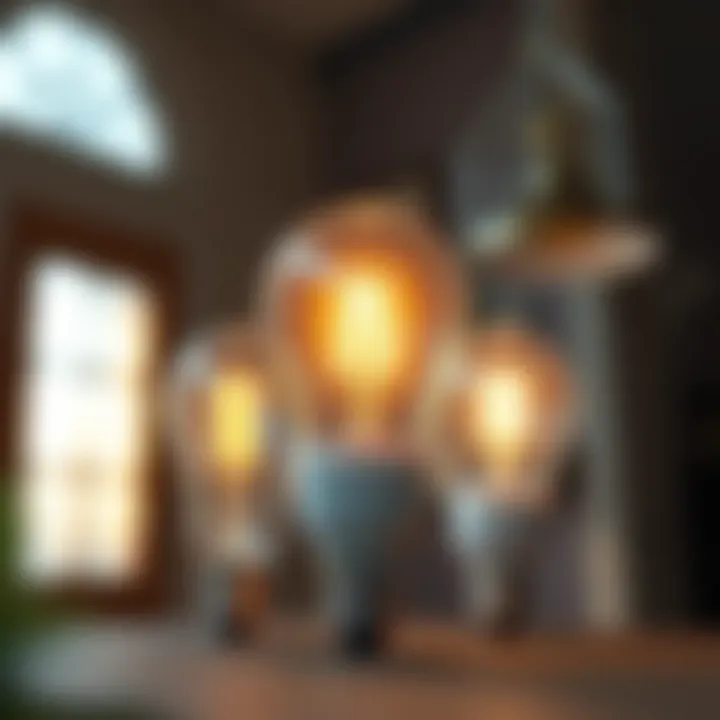
- Energy Consumption: E12 LED bulbs use about 80% less energy than their incandescent counterparts. This translates directly into lower electricity bills. For instance, if you replace a 60-watt incandescent bulb with a 9-watt E12 LED, your savings can be noticeable within the first month of use.
- Lifespan: The average lifespan of an E12 LED bulb is approximately 15,000 to 25,000 hours, compared to just 1,000 hours for an incandescent bulb. Thus, over time, you'll spend far less on replacements, with many people finding they purchase several incandescent bulbs to one LED.
- Potential Rebates: Many utility companies offer incentives and rebates for energy-efficient products. Homeowners might find that they recover a portion of their initial investment through programs that reward lower energy consumption.
"Investing in E12 LED technology not only benefits the planet but also results in a significant reduction in energy costs over time."
User Reviews and Insights from Lowe's Customers
User feedback is an invaluable resource for anyone considering E12 LED bulbs from Lowe's. These reviews not only shine a light on the products' real-world performance but also provide insights from users who might have encountered similar needs or concerns. Understanding customer experiences can guide prospective buyers in making informed choices, ensuring that the investment meets their expectations and needs.
Positive Feedback
Many customers express satisfaction with the energy efficiency of E12 LED bulbs from Lowe's. Common themes in positive reviews include:
- Brightness and Quality of Light: Users frequently highlight the clarity and intensity of the light emitted by E12 bulbs. They appreciate how these bulbs mimic natural daylight, enhancing home ambiance.
- Longevity: Several reviews mention that these LED options outlast traditional incandescent bulbs significantly. Homeowners report enjoying lower replacement costs over time, which is a big plus for budgets.
- Aesthetic Appeal: Decorative E12 LED bulbs receive accolades for their vintage design, perfect for both standard lighting fixtures and unique lamps. Customers admire their ability to maintain a stylish look while being energy efficient.
"I switched to E12 LED bulbs and couldn't believe the difference. They give off a warm, inviting glow that really brightens my room. Plus, I'm saving money on my electricity bill!"
This type of feedback is crucial for new buyers who are still on the fence about making the leap to LED technology. It captures not just the functionality but also how these bulbs can enhance overall aesthetics and joy in one's living space.
Common Issues Encountered
No product is perfect, and E12 LED bulbs are no exception. Some customers have reported issues that potential buyers should keep in mind. Here are a few of the common concerns:
- Compatibility with Dimmers: A number of users encountered problems when trying to pair their E12 LED bulbs with dimmer switches. Flickering and limited dimming range were cited, leading to frustration in achieving the desired lighting effects.
- Color Temperature Misalignment: Some customers noted that the color temperature advertised did not match what they received. This discrepancy can be disappointing, especially for those who prefer a specific ambiance created by warm or cool light.
- Initial Cost: Although LED options save money in the long run, some reviewers mention being put off by the steeper initial purchase price compared to incandescent bulbs. While they recognize the long-term benefits, the upfront costs can deter some buyers.
These insights are also essential for those considering a purchase, as they indicate the importance of checking compatibility and understanding the product's specs before committing. Knowing these potential hiccups can better prepare customers to enjoy their E12 LED bulbs, making the transition to efficient lighting smoother.
Future of E12 LED Technology
The future of E12 LED technology holds promising developments that are set to redefine lighting solutions for both residential and commercial use. As people become increasingly conscious of energy consumption and ecological footprints, advancements in lighting technology play a pivotal role in addressing these concerns. E12 LED bulbs are not just about providing light; they represent a shift towards sustainable living. The improvements in this space tackle efficiency, user experience, and environmental impact, which is crucial in today's world.
Innovations on the Horizon
As we peer into the future, technology is on the brink of some substantial innovations. One notable area of advancement is the integration of smart technology into E12 LED bulbs. Imagine being able to control your lighting from your smartphone or set up schedules for when your lights should be on or off. The development of app-controlled bulbs, which sync with home automation systems, provides greater convenience and customization. This can result in energy conservation, as homeowners can manage their power usage more effectively.
Other innovations may include the enhancement of color-changing capabilities and tunable white light features. These functionalities allow users to modify their environment depending on their needs or mood, thus enriching the space’s ambience. The ability to manipulate the light spectrum can also influence productivity and well-being, making these bulbs valuable not just in the home but also in workplace settings.
"Innovation is the ability to see change as an opportunity – not a threat."
– Anonymous
Conversely, miniaturization of the bulb’s components is also being explored. This will allow for slimmer designs that fit into tighter spaces while still delivering optimal brightness and energy efficiency. Such advancements ensure that homeowners can have versatile lighting options without compromising on aesthetics.
Sustainability Trends
Sustainability is at the heart of future E12 LED technology. With growing urgency around climate change, the push for eco-friendly lighting solutions is stronger than ever. E12 LED bulbs already have a lower carbon footprint compared to incandescent options, but further improvements are on the way.
Research is actively being conducted into creating bulbs that use sustainable materials in their construction. For instance, utilizing recyclable plastics or biodegradable components can lessen the environmental impact of lighting solutions significantly. Additionally, the industry is likely to witness advancements in production techniques, leading to less waste during manufacturing.
Moreover, the energy consumption of these bulbs is expected to further decrease while improving lumens per watt output. Higher efficiency means less strain on power grids, contributing to a reduction in fossil fuel reliance.
In summary, the future of E12 LED technology indicates a pathway toward smarter, more efficient, and eco-friendly lighting solutions that cater to the evolving needs of consumers. Innovations and sustainability trends are not only changing how we illuminate our spaces but also how we manage our energy consumption and environmental responsibilities. Homeowners, designers, and DIY enthusiasts alike are well-positioned to take advantage of these developments, ensuring their lighting choices are forward-thinking and environmentally conscious.
Closure
When it comes to choosing the right lighting for your home, understanding your options is paramount. This article has tackled the nuances of E12 LED bulbs available at Lowe's, emphasizing their energy efficiency, longevity, and versatility. As we've explored, E12 LED bulbs are not just lights; they are significant players in transforming your home into a more sustainable and aesthetically pleasing environment.
Review of Key Points
Through our journey, several key points have emerged:
- Definition and Utility: E12 bulbs, with their smaller base, are perfect for decorative fixtures. This makes them a go-to choice for chandeliers and accent lighting.
- Efficiency and Longevity: The energy efficiency of LED technology means that switching to E12 LED bulbs can result in lower electric bills and less frequent replacements.
- Diversity of Options at Lowe’s: Lowe's provides an extensive selection of E12 LED bulbs, from standard to dimmable options, catering to varied lighting needs.
- Installation Ease: Proper installation ensures not only functionality but also safety, making it a straightforward task for most homeowners.
- Innovative Trends: As technology evolves, we see promising innovations and sustainability trends within the E12 LED sector that will shape the future of lighting.
Final Thoughts
In closing, the insights gathered about E12 LED bulbs highlight their importance in modern lighting solutions. Homeowners and designers alike should consider these bulbs not only for their practical benefits but also for the aesthetic value they can bring. The shift towards LED technology signifies a move towards more energy-efficient and environmentally friendly options.
As you explore various designs and settings in your home, remember that the right E12 LED bulb can make all the difference in creating the right ambiance. Whether you are looking for efficiency, style, or innovative features, the selection at Lowe’s offers something for everyone. Embrace these lighting alternatives and step into a brighter, more sustainable future.
